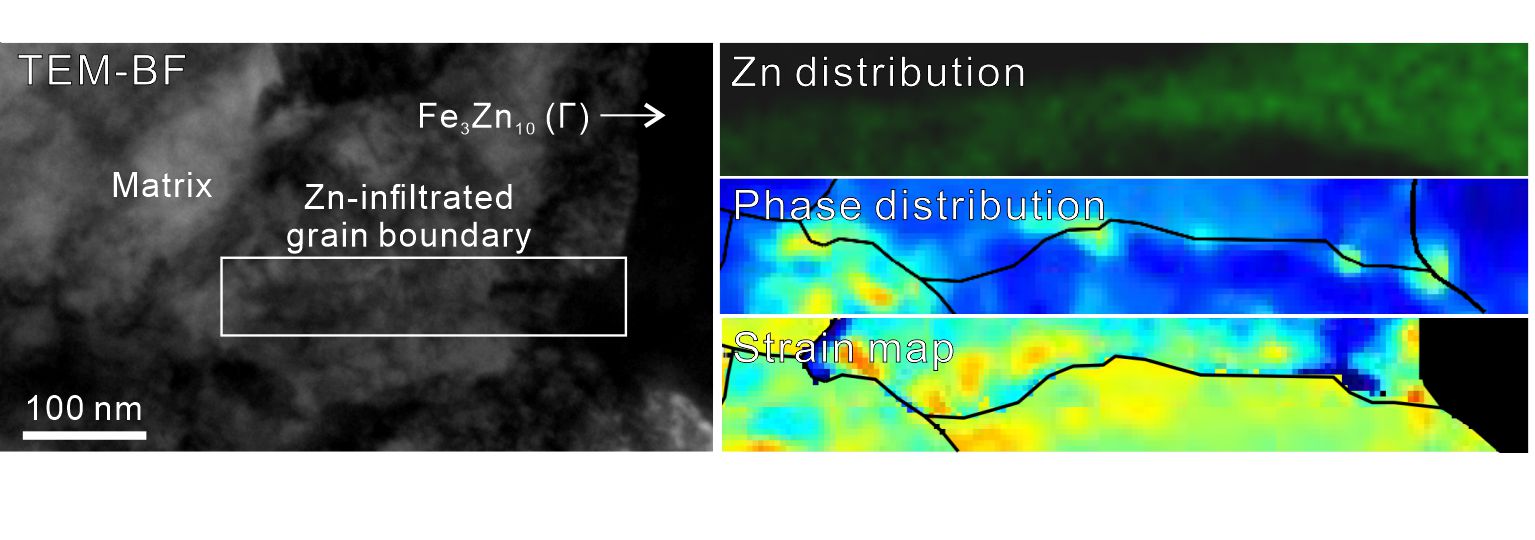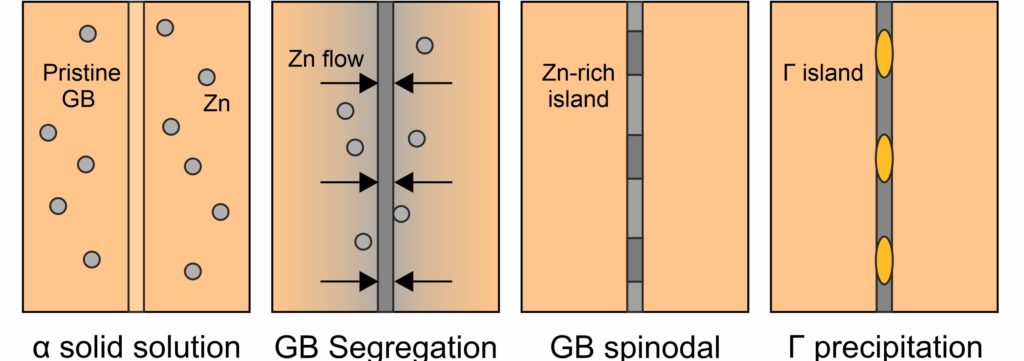Steels are a central pillar of our society, as they represent one of the most used material in construction, transportation, or energy production. Industrial steels have been around for more than a century, but material scientists and metallurgists continue to develop new steel grades that continuously push their properties to new limits. Our work supports steel development with fundamental insights into their mechanical, thermodynamic, and microstructural behavior.
Liquid-metal embrittlement in high-strength steels
Next generation high-strength steels are carefully designed complex engineering alloys that meet todays needs in weight savings and therefore energy efficiency in the transportation sector. In service, such alloys must be protected against corrosion to achieve highest possible component life times, which is commonly done with a Zn coating. Once galvanized, novel steel grades have shown to be very susceptible to so-called liquid-metal embrittlement (LME). This embrittlement emerges during joining when the Zn coating liquifies, as for example during resistance spot welding.
With our industrial collaborators at Arcelor Mittal and General Motors, we are currently unravelling the very early stages of LME. Following interrupted resistance spot welding of galvanized advanced high-strength steels of the third generation, we find that the low temperature regime below the ductility trough is critical for LME. During the first tens of milliseconds of
unravelling the very early stages of LME. Following interrupted resistance spot welding of galvanized advanced high-strength steels of the third generation, we find that the low temperature regime below the ductility trough is critical for LME. During the first tens of milliseconds of processing, high Zn-containing intermetallic phases form in the still uncracked grain-boundary network. Using 4D STEM, we can demonstrate that environments with grain-boundary intermetallics are highly stressed and that such domains seem to be the first ones to undergo decohesion.
processing, high Zn-containing intermetallic phases form in the still uncracked grain-boundary network. Using 4D STEM, we can demonstrate that environments with grain-boundary intermetallics are highly stressed and that such domains seem to be the first ones to undergo decohesion.
In concert with experiments, thermodynamic calculations are done in strong collaboration with Reza Darvishi Kamachali at the Materials Modelling Division at BAM. This effort uncovers currently the fundamentals of intermetallic nucleation in the grain boundaries. Specifically, a magnetically driven miscibility gap was found in the Fe-Zn system that promotes a giant segregation transition that facilitates the quick formation of high Zn-containing intermetallic grain-boundary phases. Our next steps involve mitigation concepts of LME to provide a fundamenta l solution to an old metallurgical problem. These new insights into LME in the Fe-Zn system were recently recognized with an award by the American Iron and Steel Institute.
l solution to an old metallurgical problem. These new insights into LME in the Fe-Zn system were recently recognized with an award by the American Iron and Steel Institute.
Read more about this work here:
- Early stages of liquid-metal embrittlement in an advanced high-strength steel
- Giant segregation transition as origin of liquid-metal embrittlement in the Fe-Zn system
- Segregation-induced grain-boundary precipitation during early stages of liquid-metal embrittlement of an advanced high-strength steel
Mechanical properties of micron-scale phases in steels
Modern technical alloys often contain a number of phases that for improved strengthening tend to be microscopic or even nanoscopic. This does not only apply to superalloys, but also to now commercially available dual-phase steels. In order to adequately model the macroscopic response of such multi-phase systems, the properties of the individual phases need to be known. To this end, we use micro- and nano-mechanical testing method to quantify local hardness, yield behavior, and strain hardening.
Read more about this work here:



